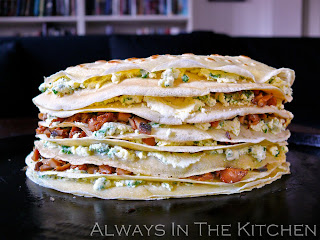
Scalloped potatoes are one of my favourite holiday side-dishes. They're quite cooperative - you can generally cook them at whatever temperature you are already using for your ham or turkey or other festive fare (simply adjust the time), and require little minding once they go into the oven. Classic, simple, and satisfying.
These are the antithesis of fast food - a slow-baking, satisfying dish that yields the unexpected dividend of being a terrific breakfast dish the next day - topped with a sunny-side or poached egg, or diced and turned into Spanish tortilla (in which case, add more garlic).
Made with milk rather than cream (but no less creamy), and with a nice sprinkle of cheese at the end, these are richer tasting than they really are. If you're having a large holiday feast with many dishes, you can easily get six servings out of this, and if you're having a pared-down holiday dinner, it serves four generously.
Scalloped Potatoes
The way my mother used to make them
Makes a 9x9 inch baking dish
Serves 4 - 6
1 kilogram half-waxy potatoes (such as Yukon Gold)
1 small onion, finely chopped
2 tablespoons all-purpose flour (approximately)
1 cup whole milk
1/2 cup coarsely grated parmesan cheese
Kosher or coarse sea salt
nutmeg
Prepare your 9x9 baking dish by lightly buttering or oiling it. Preheat your oven to 350-375 F if you don't have anything else already requiring a specific temperature.
Peel the potatoes and slice them thinly, but not quite paper thin (I disagree with the venerable Martha Stewart on that one). Peel and dice the onion. Place 1 tablespoon of flour in a very fine sieve and have it within easy reach.
Place a layer of potatoes in the baking dish, slightly overlapping the edges like fish scales. Sprinkle sparingly with salt, add about a third of the onions, and use the sieve to dust a small amount of the flour evenly over the entire dish. Repeat until you have run out of potatoes (no need to flour the final, top of the potatoes, though a further pinch of salt there is fine). You shouldn't need more flour for the layering stage than the initial tablespoon - go easy, to prevent the dish from becoming gluey.
Shake together the milk and the other tablespoon of flour, and pour it gently over the potatoes, making sure the whole top layer of potatoes gets wet with the milk. The milk should only come up about half way through the stack of potatoes - they should not be swimming in milk!
Cover the baking dish with foil, and place in the oven (I like to put a drip tray under it, in case the milk boils over) to bake for 45 minutes to one hour (test with a knife - it should slide easily through the potatoes with no resistance). If, due to the varied times and temperatures of your other dishes, your potatoes are done earlier than you need, simply remove them from the oven and hold them aside (still covered with foil) until about 15 minutes before you want to serve them (perfect resting time for a roast chicken, or duck, for example), before going on to the next step.
Remove the foil, and sprinkle evenly with the cheese. Sprinkle a delicate, tiny amount of nutmeg over the whole dish, and return, uncovered, to the oven to cook for another 15 minutes or until the top is lightly golden on the edges (or more deeply browned, if that's your preference).
Use a flipper-type spatula to loosen the edges, cut into portions, and serve.






































